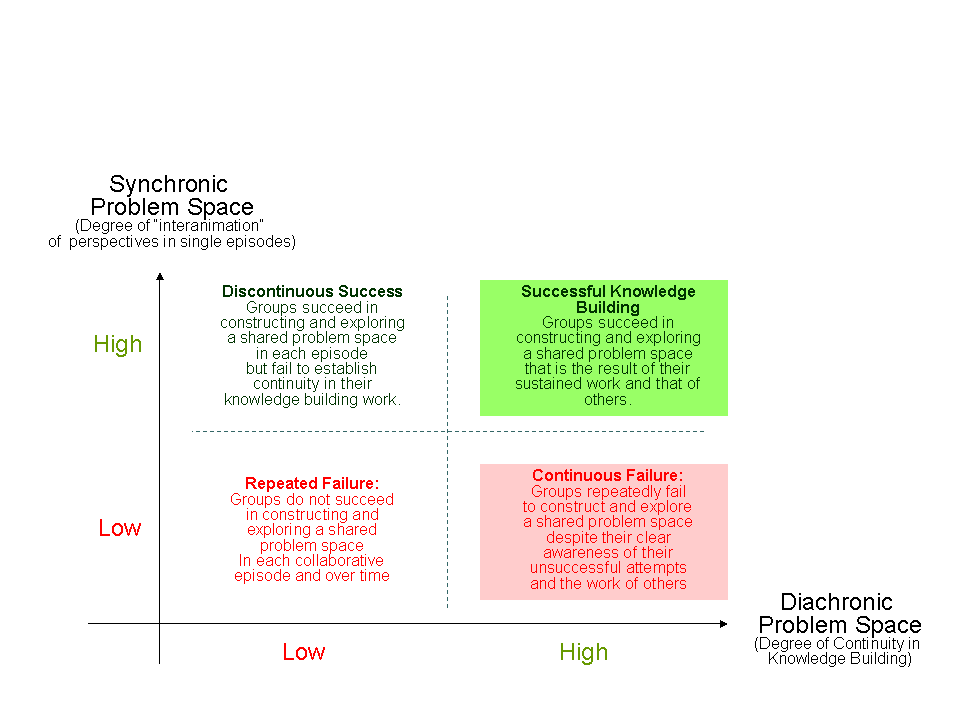Problem Space
From Jsarmi
Revision as of 16:21, 6 April 2007
Here are some reflections about how a "problem space" can be considered to be a continuous (although contingent) achievement of a group engaged in collaborative problem solving
Contents |
Problem Space and Joint/Shared Problem Space
The idea of a problem space is central to the information-processing or cognitive view of human problem solving (i.e. Newell and Simon's problem-solving theory). From this perspective, the task environment gets abstracted into an internal representation which is what the problem solver uses to actually solve the problem. This internal representation a subject is assumed to construct when s(he) understands a task correctly might contain (encode):
- The current initial state of the problem;
- The goal state or condition (as a test procedure to know when one is done, or a declaration of what the "end" is)
- Constraints determining allowable moves and states (e.g. nodes and allowable links of the space)
- Other representations encoding knowledge of problem solving methods, heuristics, or metrics specific to the current task environment, ideas about when one is getting closer to a solution, common ways of overcoming stuck states, etc.
More recently, the nature of problem-solving activity has been considered, like many other human activities, from a more situated and inherently social perspective. Roschelle and Teasley, for example, proposed the notion of a joint problem space (JPS) as a "shared knowledge structure" that supports problem solving activity by integrating:
- Goals
- Descriptions of the current problem state
- Awareness of available problem solving actions
Initially, this description does not seem too radically different than the traditional cognitive view. After all, one can conceive the "shared knowledge structure" as the intersection of the individual "mental models" or individual problem spaces. However, Roschelle and Teasley's proposal goes beyond this interpretation. From their perspective "social interactions in the context of problem solvingactivity occur in relation to a Joint Problem Space" and to a "shared conception of the problem" that results from a collaborative process of coordination of communication, action, and representation in a particular context of activity, not in the heads of the individuals. This perspective, and indeed, their method of analysis, are consistent with Garfinkel's ethonmethodological observation about the nature of "shared agreements:"
- "Shared agreement" refers to various social methods for accomplishing the member's recognition that something was said-according-to-a-rule and not the demonstrable matching of substantive matters. The appropriate message of a common understanding is therefore an operation rather than a common intersection of overlapping sets. (p.30)
From this perspective, a "shared agreement" or a "mutual conception of the problem" are the emergent and situated result of the participant's interactions, embodied in their context of activity. In the words of Roschelle and Teasley, it is "the coordinated production of talk and action by two participants (what) enabled this construction and maintenance (of the joint problem space) to succeed... the introduction of successful ideas was sometimes asymmetric, although it succeeded only through coordinated action."
More recently, other researchers have furthered the notion of a joint problem space adding more evidence to the importance for social interaction in the construction, use and maintenance of such resources. Baron (2003), for instance, argued beyond the need to "manage joint attention at solution-critical moments" as explored by Roschelle, groups face other complex challenges that when successfully managed accounted for their overall advantage over groups with equivalent capacity. In particular, she argued that there are critical challenges to the creation of joint problem-solving spaces as individual participants are simultaneously managing their own efforts to understand pieces of the problem and at the same time trying to understand what others are doing. As a result, Baron argues that "collaboration might productively be thought of as involving a dual-problem space that participants must simultaneously attend to and develop." This dual space" comprises:
- A content space consisting of the problem to be solved, and
- A relational space consisting of the interactional challenges and opportunities.
Baron argues that the content space and relational space are negotiated simultaneously but can compete for limited attention, "one needs to be able to monitor and evaluate one’s own epistemic process while tracking and evaluating others’ epistemic processes." An example of how these two spaces intersect and one that Baron follows through her entire analysis of group problem solving is the management of problem-solving proposals. A problem-solving proposal has both a relationship with the content space or problem space and to the social interaction of the group. It involves elements of the problem or of a strategy that might require attention, offer a new insight, or might indicate a solution path. At the same time, they are "bids" for collective action, requests for co-participants to, perhaps, interrupt their current activity, and in some cases, contrasting alternatives to other proposals already stated. This "dual" character of the interaction space expands our understanding of what a "joint problem space" entails, although, it is clear that the two "aspects" of this dual space are mutually constitutive.
Situated Cognition and Distributed Cognition (maybe distributed problem space?) too.
Boundaries of a Shared Problem Space
The distinction between the cognitive view of a problem space as an idealized structure in someones head and a problem space as the emergent of people engaged in problem solving activity, can be explored from the perspective of boundaries:
- Where does the problem space, physically, stop?
- When does the problem space can be said to no longer exist?
Groups and their Shared Problem Space
Here is a possible distinction of the work of groups, pased on both their synchronous problem space and their diachronic problem space

References
Roschelle, J. & Teasley, S.D. (1995). Construction of shared knowledge in collaborative problem solving. In C. O’Malley (Ed.), Computer-supported collaborative learning. New York: Springer-Verlag. Garfinkel, H. (1967) Studies in Ethnomethodology. Englewood Cliffs, NJ: Prentice- Hall. (Some essential features of common understandings)
